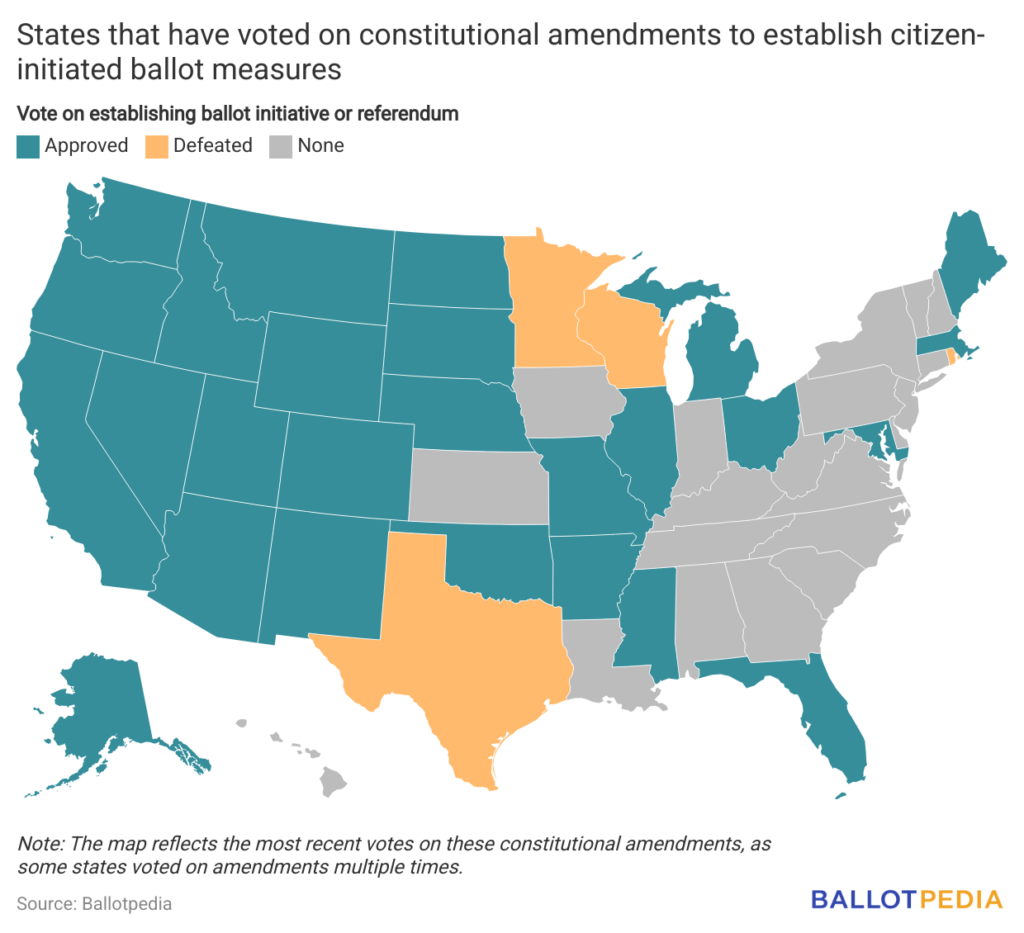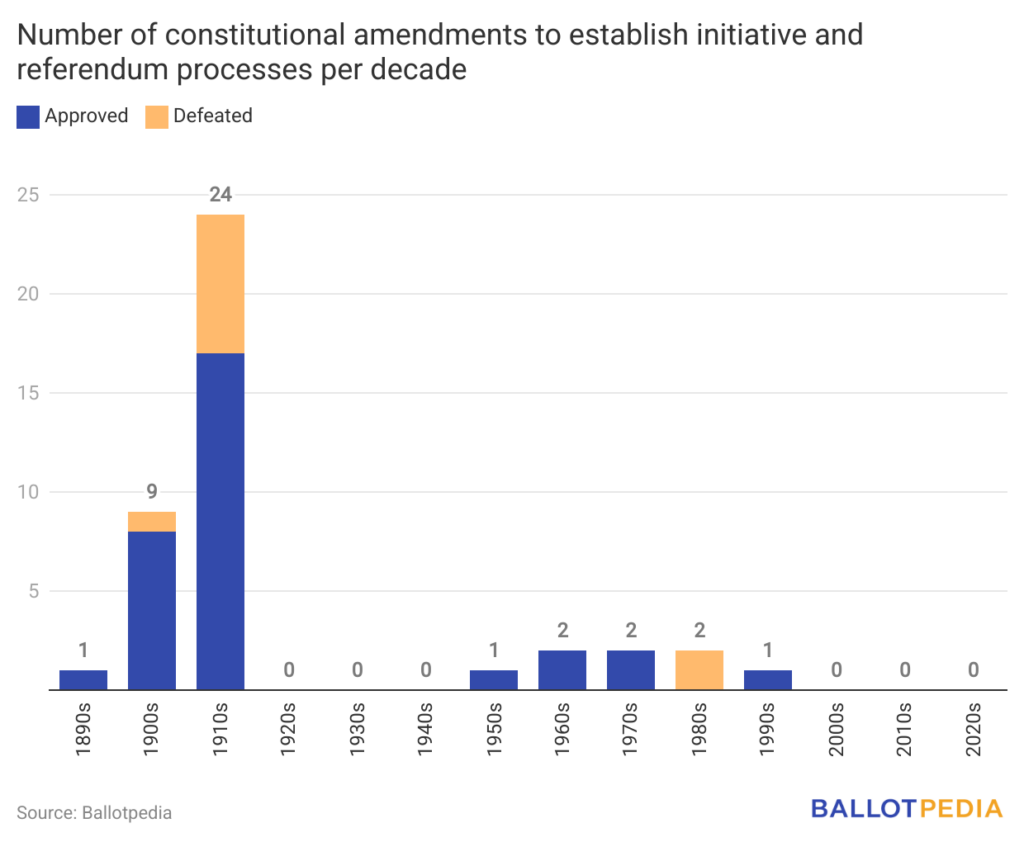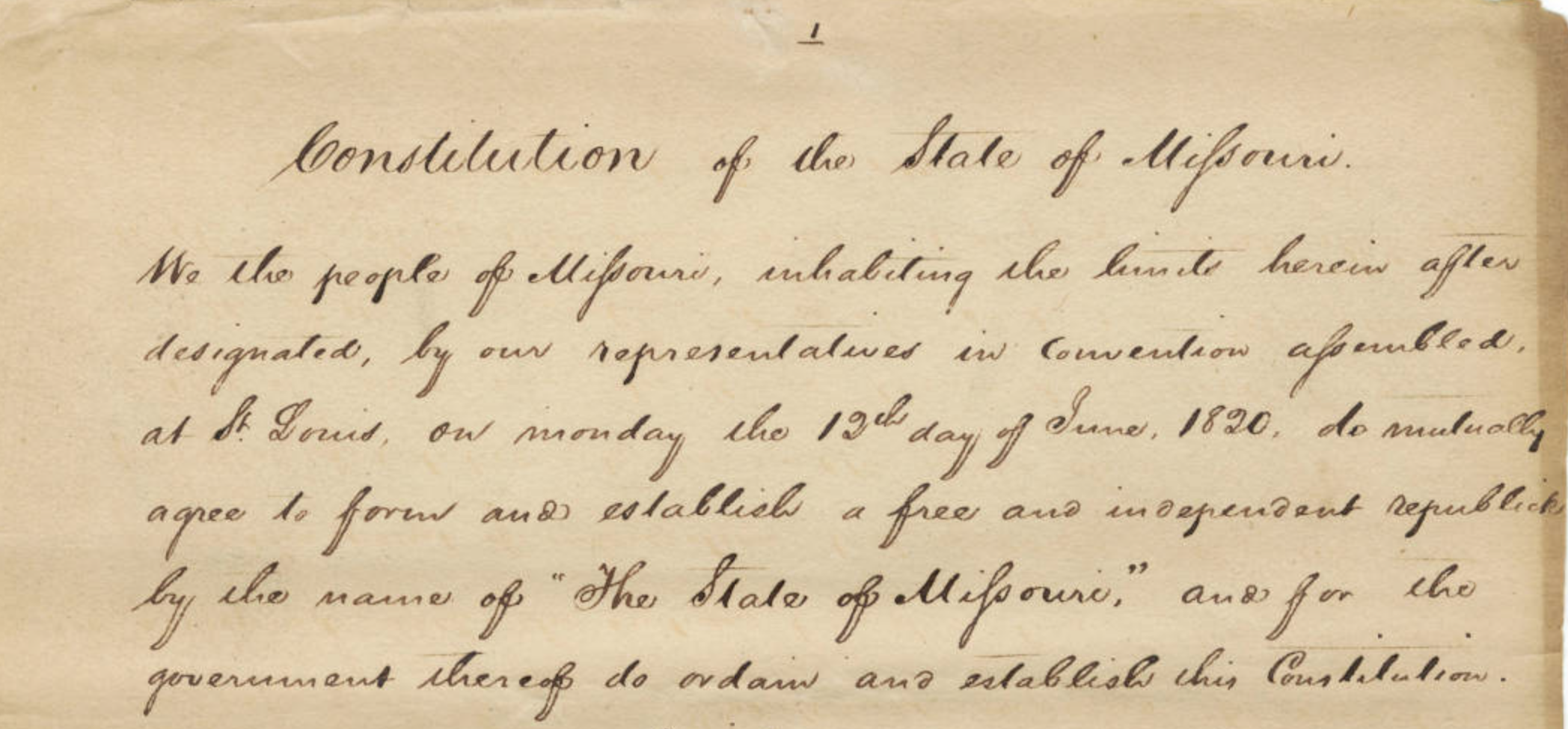In the U.S., 26 states have adopted constitutional amendments for citizen-initiated ballot measures. As state constitutional amendments require voter approval, except in Delaware, creating ballot initiative processes requires ballot measures, either from state legislatures or constitutional convention. Most of these amendments originated during the progressive and populist movements of the 1890s to 1920s.
Beginning in 1898, voters in 30 states have decided on 42 constitutional amendments to create state initiative and referendum processes. The average vote on a constitutional amendment to establish an initiative or referendum process was 68.25% 'Yes' to 31.75% 'No'.
South Dakota was the first state to adopt an initiative and referendum process in 1898. Amendments were adopted in 22 states between 1898 and 1918, a two-decade period.
After 1918, there were no constitutional amendments to enact an initiative or referendum process on the ballot until 1956, when Alaskans adopted a state constitution that included both. In the 1960s, 1970s, and 1980s, two constitutional amendments appeared on the ballot during each decade.
In 1992, Mississippi became the most recent state to pass a constitutional amendment for an initiative process. Since then, no constitutional amendments have been placed on the ballot to establish an initiative or referendum process.
States that have voted on initiative and referendum ballot measures
Voters in 30 states have decided on constitutional amendments to establish initiative and referendum processes, with voters in 26 states approving them.
- Nebraska Amendment 1 in 1912 won the widest margin for a constitutional amendment, receiving 92.51% of the vote. Wisconsin Question 2 of 1914 had the largest margin of defeat, receiving 36.38% of the vote.
- Massachusetts Question 1 in 1918 had the smallest winning margin, with a vote of 51.28% to 48.72%. Texas Proposition 1 of 1914 had the smallest losing margin, with a vote of 48.29% to 51.71%.
- The four states that voted on constitutional amendments to establish initiative and referendum processes but never approved one are Minnesota, Rhode Island, Texas, and Wisconsin.
- In Minnesota, voters defeated constitutional amendments in three elections: 1914, 1916, and 1980.
- Voters in three states—Mississippi, Missouri, and Wyoming—rejected constitutional amendments before approving amendments on second attempts.

Timeline of initiative and referendum ballot measures
In 1898, South Dakota became the first state to both vote on and approve a constitutional amendment establishing a state initiative and referendum process. The amendment provided for initiated state statutes and veto referendums. South Dakotans would also gain the power to initiate constitutional amendments in 1972.
Between 1900 and 1909, voters in eight states decided on nine constitutional amendments to establish initiative and referendum processes. Utah became the second state to approve an amendment in 1900, and Oregon the third in 1902. Voters also adopted amendments in Maine, Montana, and Nevada within the decade. In Oklahoma, the initiative and referendum process was included in the state's first constitution, and, in Michigan, voters approved a revised constitution including the initiative and referendum.
In 1904, Missouri became the first state where voters rejected a constitutional amendment to provide for initiative and referendum. The vote was 40.61% 'Yes' to 59.39% 'No.' However, voters approved a constitutional amendment four years later in 1908.
The decade also included non-binding questions about establishing an initiative and referendum process in Illinois and Delaware. Although these non-binding questions were approved, Illinois did not establish an initiative process until 1970, and Delaware never adopted one.
The 1910s featured the most constitutional amendments to establish initiative and referendum processes, with 24 across 18 states.
In 1912, more constitutional amendments were proposed to establish the initiative and referendum processes than in any other year. Voters approved amendments in Idaho, Nebraska, Nevada, Ohio, and Washington. In Mississippi and Wyoming, constitutional amendments were rejected because they received a majority of votes but failed to meet the states' supermajority requirements.
Voters in Mississippi approved a constitutional amendment two years later in 1914. However, in 1922, the Mississippi Supreme Court ruled the ballot measure invalid, finding that providing for both initiated state statutes and initiated constitutional amendments within a single measure was unconstitutional.
In 1914, North Dakotans approved constitutional amendments providing for initiated state statutes and referendums and initiated constitutional amendments. In Texas and Wisconsin, voters rejected constitutional amendments in 1914. In Minnesota, constitutional amendments were defeated in 1914 and 1916 because, while they received a majority of votes on the measures, they did not meet the state's requirement of a majority of all ballots cast in the election.
In 1915, voters in Maryland approved a constitutional amendment to provide for a veto referendum process. In 1918, a constitutional amendment for initiative and referendum was approved in Massachusetts.
After 1918, no new constitutional amendments to create initiative and referendum processes were referred to voters for the next 38 years.
In 1956, voters in Alaska approved a state constitution that included the initiative and referendum process. In 1968, Floridians approved a revised constitution that included the initiative and referendum process. In Wyoming, 56 years after an amendment was defeated in 1912, the legislature referred to the ballot a new amendment, which voters approved in 1968.
In 1970, voters in Illinois approved a revised constitution, which included a process for initiated constitutional amendments limited to "structural and procedural subjects contained in Article IV."
In South Dakota, the first state to adopt an initiative and referendum process in 1898, voters approved Amendment E, which expanded the initiative power to include citizen-initiated constitutional amendments in 1972.
Voters in Minnesota considered Amendment 5 in 1980, which was the third time voters in the state decided on an initiative and referendum amendment. As with the votes in 1914 and 1916, the amendment received a majority of votes cast on the measure but failed to meet the state's requirement for a majority of all ballots cast in the election.
In 1986, voters in Rhode Island rejected Question 5, which would have provided for citizen-initiated ballot measures, among other changes. Voters approved a non-binding question about initiatives in 1996.
The most recent state to both vote on and approve a constitutional amendment to establish an initiative process was Mississippi in 1992. Titled Amendment 8, the ballot measure received 70.22% of the vote. The constitutional amendment included a signature distribution requirement based on five congressional districts. However, according to the Mississippi Supreme Court, the requirements cannot be met because the state had four congressional districts following reapportionment in 2001. While the constitutional amendment providing for the initiative process in Mississippi remains valid, the signature distribution requirement cannot be met, preventing initiatives from being certified for the ballot.

For a comprehensive list of these ballot measures, see Ballotpedia's page on the history of ballot measures to establish initiative and referendum processes.
Additional reading:


